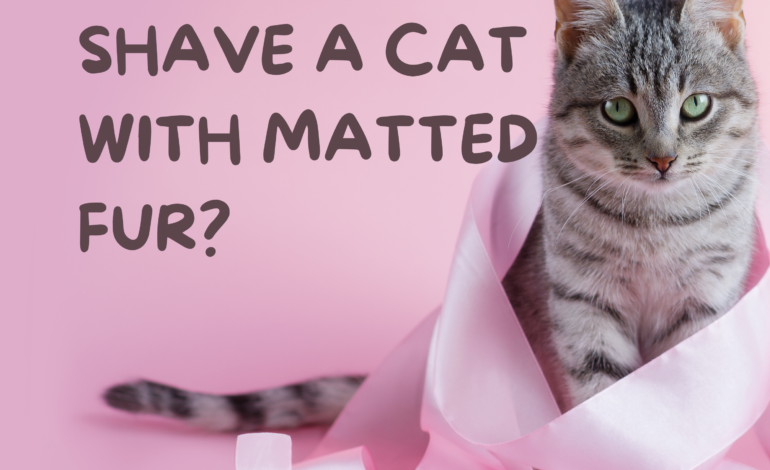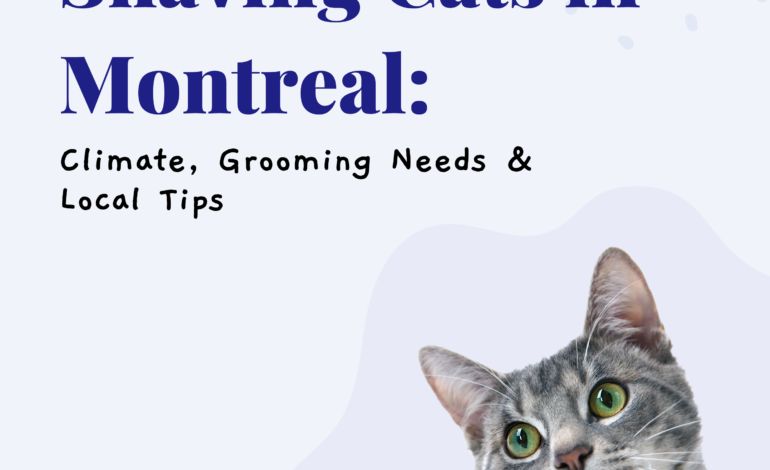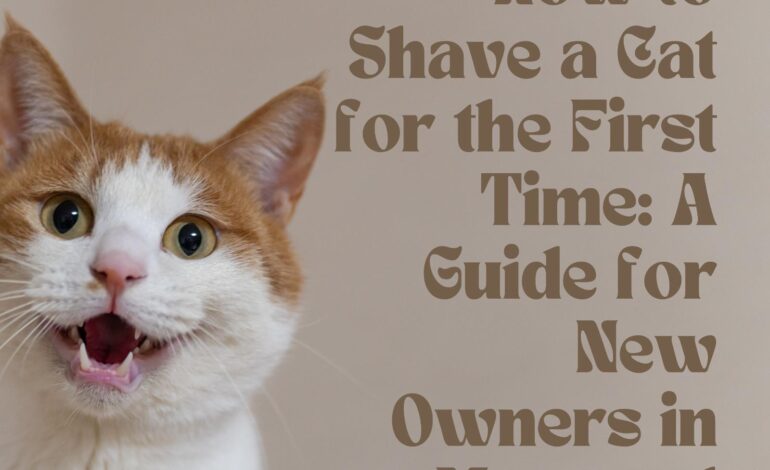How To Shave A Cat With Matted Fur?

Clumped hairs that weave themselves into tight tangles and become matted can be quite a nuisance. In some cases, the most humane thing to do in order to maintain comfort and avoid health complications is to shave the cat.
Skin in general has an average thickness of about 0.4 to 2 mm,(1) and so is particularly vulnerable to injury during grooming if the cat is not handled with caution. In addition, with the disproportionate length of a cat’s limbs in comparison to its body, it has a wider range of motion which increases the likelihood of getting unintended cuts during a shave.
In this guide, explain the basic steps on how to shave a cat with matted fur, focus on those with a dislike to grooming, and cover safety measures as well as aftercare.
Why Shaving a Cat with Matted Fur May Be Necessary

Untended matted fur not only looks bad, but can also hurt your feline friend.
- Pain and Skin Irritation: Skin irritations and infections can start from even the smallest hair mats which can cause some pain and soreness. (2)
- Movement Issues: Mats of fur which are packed or thick can make moving about somewhat harder. The rest of the fur which does not become matted pulls on the skin resulting in pain and discomfort.
- Hygiene Concerns: Mats of fur collect and hold parasites, moisture, and dirt. Having mats of fur greatly increases the chance of painful sores and infections and should be avoided.
- Health Conditions: Sick or older cats may stop grooming themselves, which increases the severity of the mats and, as a result, the cat’s skin which provides support becomes less elastic and prone to injuries. (3)
Blocked or matted fur in cats like the Persian and Main Coons, is the easiest to forget about. The areas behind the ears, near the tail, or under the legs are especially hard to reach.
Signs Your Cat’s Mats Require Immediate Attention

So how do you know when a mat is serious enough to need shaving instead of brushing? Look for these red flags:
- Thick, hard mats that feel like rugs: These mats can be really uncomfortable and if not fixed can really hurt the skin and get infected.
- Painful reactions when touched: If your cat seems to be hurting when you pet the matted areas, you can be certain that the mats are the problem.
- Redness, scabs, or missing fur beneath mats: These symptoms may indicate that the mats, which can cause skin damage and could need a vet, have been present for quite some time.
- Cats that stop grooming themselves: Stopping grooming all of a sudden may suggest that something could be wrong which could be terrible pain due to matting.
Check with a groomer or vet, some mats can be really tight and could hurt the cat if removed, not all mats can be removed at home safely.
Essential Tools for Shaving a Matted Cat at Home

To ensure a safe and effective grooming experience for your cat, gather the following tools:
1. Quiet, Pet-Safe Clippers
- Opt for clippers designed specifically for pets, which offers adjustable speeds and is quieter than human clippers, reducing stress for your cat.
2. Dematting Comb or Rake
- Use a dematting comb to gently work through loose fur and minor mats before shaving.
3. Detangling Spray
- Apply a pet-safe detangling spray to stubborn mats to loosen them, making the grooming process smoother.
4. Round-Tip Grooming Scissors
- For minor trimming, use round-tip grooming scissors to safely cut through mats without risking injury.
5. Towels
- Wrap your cat in a towel to keep them calm and secure during the grooming process.
6. Treats
- Reward your cat with treats after each grooming session to reinforce positive behavior.
🛑 Important Tip:
- Avoid using human clippers or dull scissors, as they can pull fur or nick delicate skin, leading to injury.
How to Shave a Cat with Matted Fur at Home: Step-by-Step

| Step | Action | Tips & Notes |
| 1 | Create a Calm, Safe Environment | Choose a quiet room, use a towel or mat, dim lights, play soft music, consider pheromone sprays |
| 2 | Introduce the Clippers Slowly | Let cat sniff clippers, turn them on at a distance, gradually approach, reward calm behavior |
| 3 | Prepare Your Cat’s Fur | Brush loose fur and minor tangles, trim severe mats gently with round-tip scissors, keep fingers between mat and skin |
| 4 | Hold Your Cat Steady | Ask a helper to steady your cat. Hold them gently but firmly enough to feel secure, but never tight or stressful. |
| 5 | Shave With the Direction of Hair Growth | Start with back, use short strokes, stretch skin slightly to avoid nicks or clipper rash |
| 6 | Work in Sections | Move methodically, take breaks if stressed, offer treats or petting |
| 7 | Be Extra Careful Around Sensitive Areas | Belly, tail, neck, joints have thinner skin, use slower clipper speeds, move slowly |
| 8 | Aftercare | Wipe loose fur, apply pet-safe moisturizer, keep warm, reward with treats and play |
How to Shave a Cat That Hates It
Some cats strongly resist grooming, which can make shaving stressful for both pet and owner. Follow these tips to make the process safer and calmer:
- Stay Calm
- Cats are highly sensitive to human emotions; fear or tension can increase their stress hormone (cortisol) by up to 30% during grooming.
- Cats are highly sensitive to human emotions; fear or tension can increase their stress hormone (cortisol) by up to 30% during grooming.
- Wrap Them Gently
- A towel “burrito” technique exposes only the matted area while keeping your cat secure, reducing the risk of scratches or sudden movements.
- A towel “burrito” technique exposes only the matted area while keeping your cat secure, reducing the risk of scratches or sudden movements.
- Use Distractions
- Treats, toys, or a helper can redirect attention. Positive reinforcement increases grooming tolerance and can shorten grooming sessions by up to 40% in anxious cats.
- Treats, toys, or a helper can redirect attention. Positive reinforcement increases grooming tolerance and can shorten grooming sessions by up to 40% in anxious cats.
- Choose the Right Time
- Groom after meals or during nap time when your cat is naturally more relaxed. Cats are less likely to resist when calm and satiated.
- Groom after meals or during nap time when your cat is naturally more relaxed. Cats are less likely to resist when calm and satiated.
- Know When to Stop
- If your cat becomes aggressive or overly stressed, pause and try again later, or seek professional grooming help. Forcing a cat can lead to injuries or long-term grooming aversion
Preventing Mats in the Future
- Regular Brushing
- Daily for long-haired cats; 3–4 times per week for short-haired breeds
- Regular grooming reduces mat formation by up to 80% and improves skin health.
- Proper Diet & Hydration
- Diets rich in omega-3 and omega-6 fatty acids help keep fur soft and shiny.
- Adequate hydration prevents dry, brittle hair that mats easily.
- Check Trouble Spots
- Focus on ears, under legs, and tail base; these areas often mat first due to limited self-grooming.
- Early detection allows for gentle brushing before mats tighten.
- Professional Grooming
- For cats resistant to brushing, occasional professional grooming can prevent mats from forming and reduce stress for both cat and owner.
Final Thoughts
Doing a shave at home on a matted cat can seem really scary, but with the right attitude, calmness, and tools, it can be done with ease. Even the hardest to handle or groom a cat with mats, can with a gentle approach and slowly start the process, start to appreciate the extra attention especially with the addition of treats and considerable praise.
For the cat, it’s not about the look of the coat, but the positive and soft approach that makes them comfortable and free of mats. It’s somehow appreciated that, with the same approach, the veterinarians and cat groomers won’t hesitate to undo the messy situation in a professional manner.
Proper grooming should also focus on proper maintenance, comfort, health and the overall well-being of the cat. Even the hardest to deal with stubborn mats can still be managed with the proper approach and right attitude.
🐾 Ready to Make Grooming Easy and Stress-Free?
Don’t let matted fur or grooming struggles come between you and your cat’s comfort. Explore Meow Care Hub’s expert guides, tips, and recommended tools to keep your feline friend happy, healthy, and mat-free.
✅ Learn more today and turn grooming into a bonding experience both you and your cat will love!
Visit Meow Care Hub
FAQs
Q: How often should I brush my cat to prevent matting?
A: Long-haired cats benefit from daily brushing; short-haired cats should be brushed 3–4 times per week.
Q: Can I use human clippers on my cat?
A: No. Human clippers can pull fur and cut skin. Use quiet, pet-specific clippers.
Q: Is it safe to shave my cat completely?
A: Only if necessary. Leave at least 1/4 inch of fur to protect the skin. A groomer can advise if unsure.
Q: How do I shave my cat’s matted fur safely?
A: Use pet-safe clippers, work in sections, shave with hair growth, take breaks, and prioritize calm and gentle handling.
Q: When should I take my cat to a professional groomer?
A: Severe mats, aggressive or anxious behavior, or skin sensitivity warrant professional help.
Resources:





